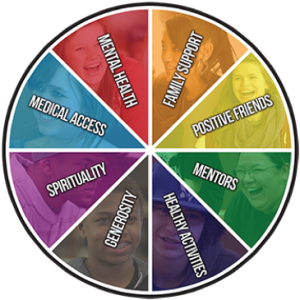If you ask Mark LoMurray what he likes most about his job, he doesn’t have to think about it much. “Watching young people find their voice,” he says, “sometimes in as little as 3 or 4 hours. We often have kids who can barely say their name at the beginning of an activity, and by the end they’re standing up presenting ideas that they’re proud of. It’s just really amazing to watch that happen.”

LoMurray is the Founder and Executive Director of Sources of Strength, an evidence-based youth suicide prevention program that, since its rollout, has expanded to address other issues like bullying, substance abuse, and violence. The program relies on trained peer leaders who work with adult advisors — usually in school settings — to facilitate activities that help young people identify and foster the strengths they need to deal with “the rough stuff,” as LoMurray calls it.
Nationwide data tells us that building up those strengths is critical for the health and safety of young people. According to the Centers for Disease Control and Prevention (CDC), suicide is the second leading cause of death for young people ages 15 to 24, causing about 5,000 deaths in 2014.
“We work with peer leaders to spread what we call hope, help, and strength messages,” explains LoMurray. “It’s all about positive social norming. If you want behavior change, you have to get somebody to model that behavior within their peer network.”
Beyond Crisis Management
Before founding Sources of Strength in 1998, LoMurray was working in a North Dakota police department, where at one point he saw 30 teen suicide deaths in less than 3 years. He already had experience in civilian crisis intervention, particularly with teen suicide prevention, and he saw an opportunity. “I was feeling like we could get in front of it,” he says.
That’s what Sources of Strength is all about. “If you think of [suicide prevention] work as a waterfall, I’d say 95% of the focus is right above or right below the fall. It’s crisis response,” explains LoMurray. “Where Sources of Strength is different is that we’re working upstream from that. We’re trying to catch students and support them way before they become suicidal. We want to normalize the fact that none of us are making it through life without going through some rough stuff.”
Evaluation Study: Sources of Strength
Sources of Strength was the subject of one of the Nation’s largest studies on peer leaders and their impact on suicide prevention. Findings from this study showed that completion of the peer leader training caused:
- An increase in peer leaders’ school engagement and connectedness to adults
- Peer leaders to be 4 times more likely to refer a suicidal friend to an adult for help
School wide, the program also:
- Increased positive perceptions about how acceptable it is for suicidal young people to seek help
- Increased positive perceptions about adult support for suicidal young people, particularly among students with a history of suicidal thoughts
The Sources of Strength Wheel

Sources of Strength is built around a wheel of 8 strengths — things like family support, positive friends, healthy activities, and mental health — that peer leaders use to help other young people develop critical coping skills. The program taps into all kinds of activities: talking in various group sizes, playing games, using social media, and creating art. Activities often involve students sharing their life experiences while others listen.
LoMurray recalls a peer leader sharing with a group how she had recently lost her mother. She talked about what helped get her through this difficult time: her aunt (family support), her love for basketball (healthy activities), and her school counselor (mental health). She ended up sharing examples of 5 of the 8 strengths in just a few minutes. “When she did that,” says LoMurray, “she taught everyone what coping looks like in real life. No amount of motivational speaking is going to get anywhere near the impact of a peer leader sharing real-life strengths.”
Changing the Conversation
Perhaps the defining characteristic of the Sources of Strength program is its inherent positivity. Instead of focusing only on the difficult situations or uncomfortable feelings the students are dealing with, the program encourages them to reframe their thinking around what can help them work through things. “We change the conversation to strengths,” says LoMurray.
As an example, he explains that they might ask a group of students to raise their hands to show which emotion they struggle with most: anger, anxiety, or depression (“The big 3,” as LoMurray calls them). “We normalize the fact that everyone wrestles with these emotions in life, and then we flip it: ‘What strengths help you deal with them?’ You get students who have focused a lot on what’s wrong. For them, just being able to talk about what’s right can go a long way. It’s incredibly empowering.”
The importance of positivity applies to the adult advisors, too. “You can have a great group of peer leaders going, but sustaining them is impossible without those adults. You have to find advisors with the right tone — with positivity.”
Next Steps
So what’s next for Sources of Strength? LoMurray has a lot of ideas — and he’s thinking internationally. “We’ve started to do some work in New Zealand and Australia, and we’re getting more requests from Europe. We’re encouraged that this is a culturally flexible program — we can adapt the wheel of strengths to make it appropriate for other cultures.”
LoMurray has good reason to think that the Sources of Strength approach will translate. He’s already seen it at work in native communities in the Arctic regions, like Alaska — places with very high rates of suicide. “There are big challenges, but we’re seeing some really promising work.”
For LoMurray, at the end of the day, it all comes back to seeing the transformation of the peer leaders. “As they’re able to give examples of why something’s working for them, they can start piecing those different strengths together as part of their story. That can be contagious. It spreads strength and hope throughout their school as they get others to talk, write, draw, and post about their strengths,” he says.
“That’s the heartbeat of resiliency.”